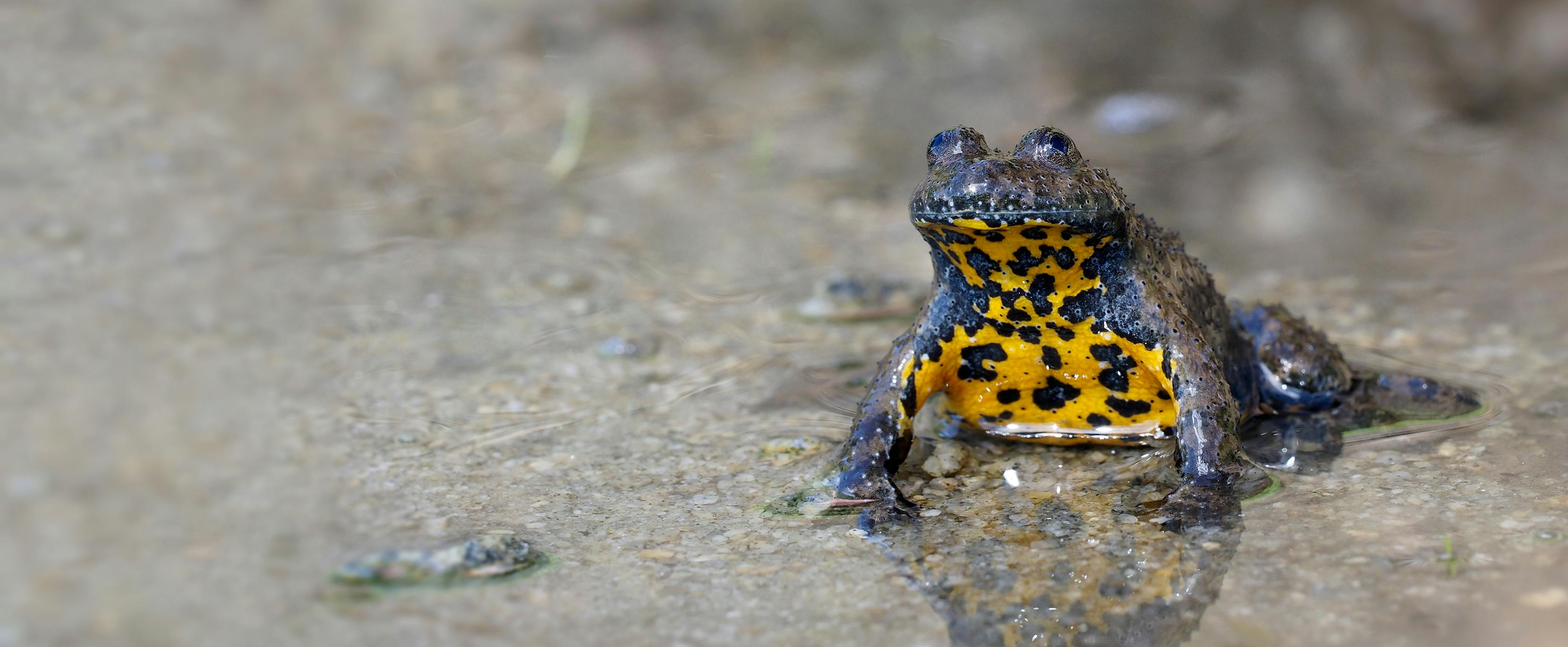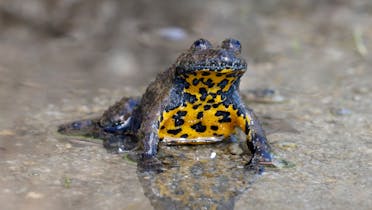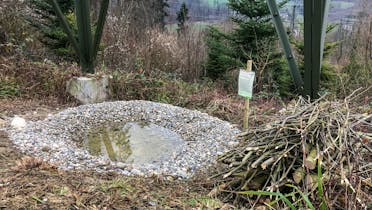
Have you ever heard of the yellow-bellied toad? These tiny amphibians, barely 5 cm long, live in Switzerland on the north side of the Alps up to 700 metres above sea level. With their brown backs, the animals hardly stand out at all in their natural habitat. But beware, if the yellow-bellied toad feels threatened, it has a reflexive reaction which causes it to show the yellow belly which gives it its name.
We should become acquainted with the yellow-bellied toad; it is highly endangered in Switzerland and neighbouring countries. Its numbers have seen a sharp reduction, so much so that it is expected to become extinct in many regions. The reason behind this is loss of habitat, resulting partly from the drainage of wetland and river engineering. «Yellow-bellied toads need a diverse, ecologically well-connected habitat containing bodies of water that dry out at certain times», explains biologist Mario Lippuner from KARCH, Switzerland's Coordination Centre for the Protection of Amphibians and Reptiles. They lay their spawn in small, temporary ponds, often when there are no other species living in the water. Other species, such as dragonfly larvae, are a threat to the yellow-bellied toad's tadpoles. «That's why it's essential that the pond will dry out again, even if this poses a certain risk to the young animals. It's important for the process to be quick», says Andrea Haslinger from Pro Natura. «Warm water is ideal. This helps the metamorphosis.»
Yellow-bellied toads need a diverse, ecologically well-connected habitat containing bodies of water that dry out at certain times.
Keeping the yellow-bellied toad population stable therefore requires lots of small, temporary ponds. But where should these habitats be created? Where can these ponds be placed so as not to cause a nuisance? naturschutzlösungen had an excellent idea about where to locate them: underneath Swissgrid's extra-high-voltage masts.
The space underneath the masts: untapped potential
The space underneath the masts of the 6,700-kilometre-long extra-high-voltage grid is perfectly suited to the placement of small ponds. The land is lost space, which cannot be used by landowners or farmers. But yellow-bellied toads aren't present at all locations where there is a mast. Pro Natura and naturschutzlösungen have cross-referenced Swissgrid lines with the information from Info Species to identify locations with both masts and yellow-bellied toads. The aim was to find masts in forests or in the vicinity of forests, given that adult yellow-bellied toads live not only in water, but also in piles of wood, loose soil and dense vegetation.
In light of this, Mühleberg was selected as the perfect location for the pilot project. Ten ponds were created and soon populated with yellow-bellied toads. The work was done by hand. A protective fleece was laid inside the pit, on top of which a rubber liner was placed. «A soakaway and a hole were made at the deepest point to ensure that the water can flow away and the temporary ponds do not become permanent», explains Andrea Haslinger. In addition, the ponds must be situated at least one metre away from the mast foundations for maintenance purposes. In the ponds themselves, small hideaways made from large stones or rootstocks were created. Miniature structures offer the adult yellow-bellied toads, and other species, a place to live.
Similar projects are planned. But things are not as simple as they seem. «In several cantons, construction permits are needed for such installations,» explains Andrea Haslinger. Aside from this, implementation is dependent on the season. «We can only make the ponds in winter, between November and March», she explains. This is because the mating season of the yellow-bellied toad begins in April. The preliminary work – inspecting the locations and holding discussions with the canton, municipalities, local nature conservation associations, landowners and farmers – is carried out carefully by Pro Natura. In this way, they can ensure that the ponds will remain undisturbed. KARCH is also involved in the preliminary work. The amphibian specialists pass on useful tips and tricks to the project organisers.
Yellow-bellied toads have an all-or-nothing strategy. In temporary ponds, they run the risk of their tadpoles dying when the water dries up.
And what does Swissgrid do? The national grid company surveys the locations with the project organisers, provides the necessary geodata and specifies which conditions must be adhered to to ensure line security. «From our perspective, projects like this are very valuable, and we are thrilled that Pro Natura and naturschutzlösungen have taken the initiative», explains Barbara Krummenacher, Grid Project Engineer at Swissgrid. Networking is not only a priority for the power system, but also for the protection of nature and the environment.







